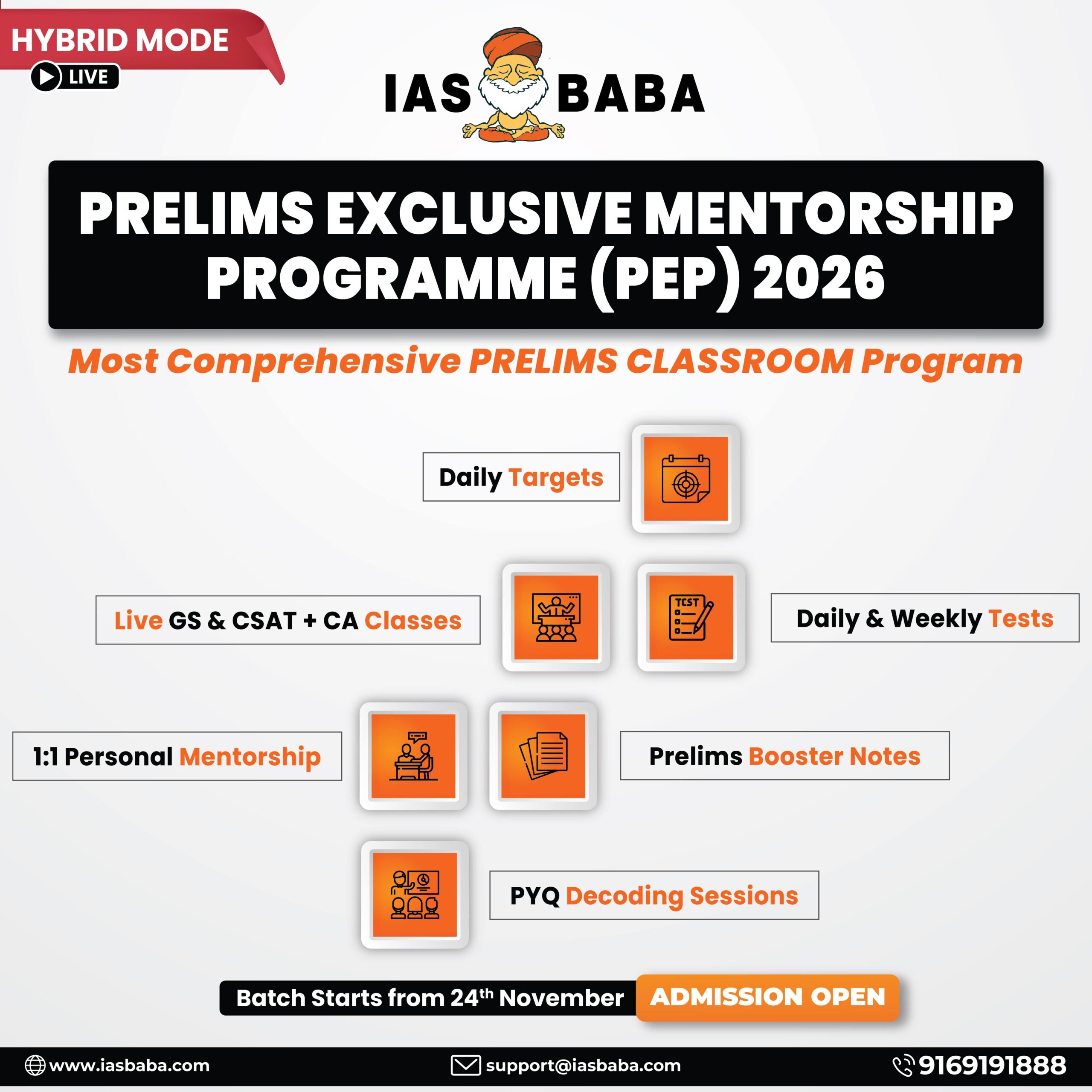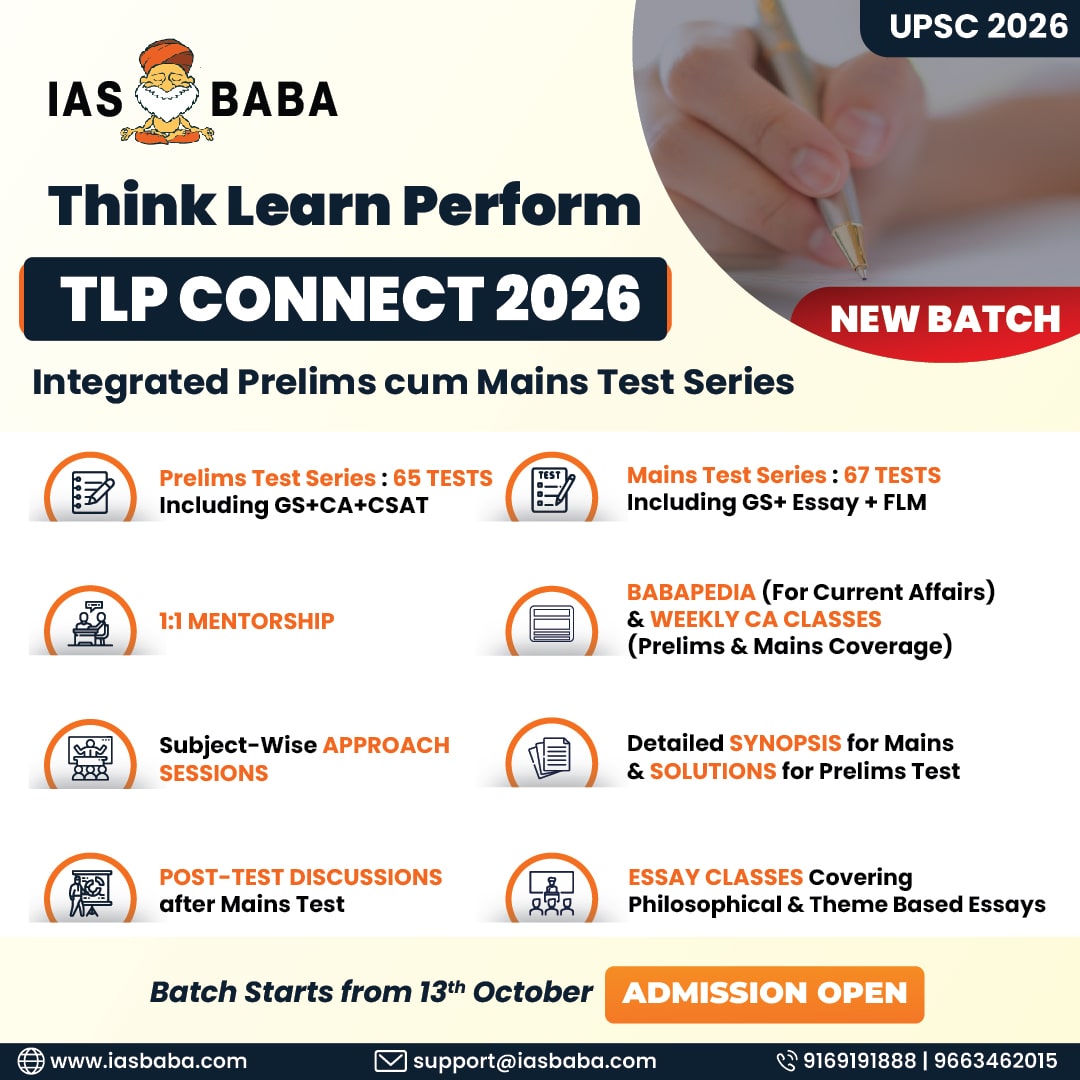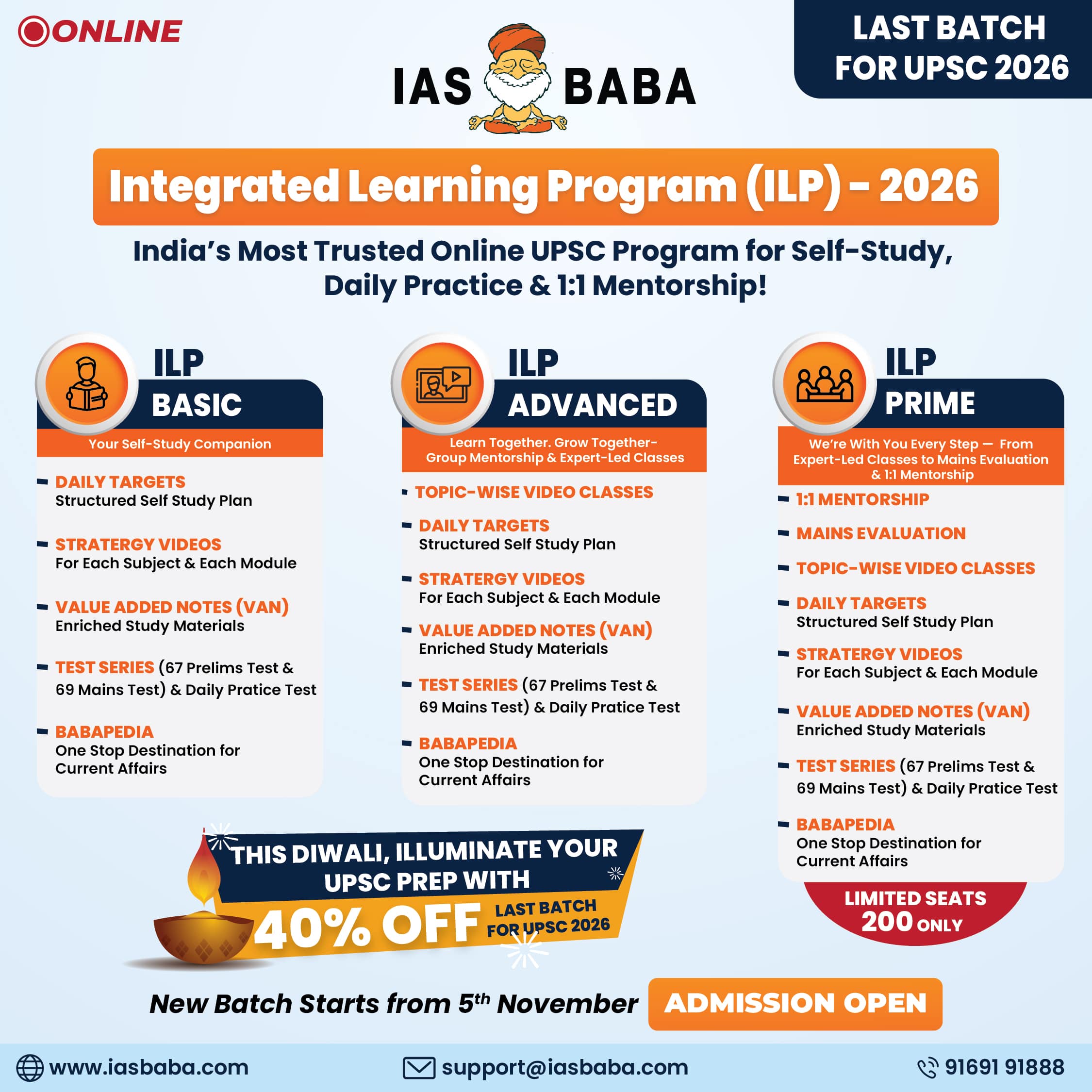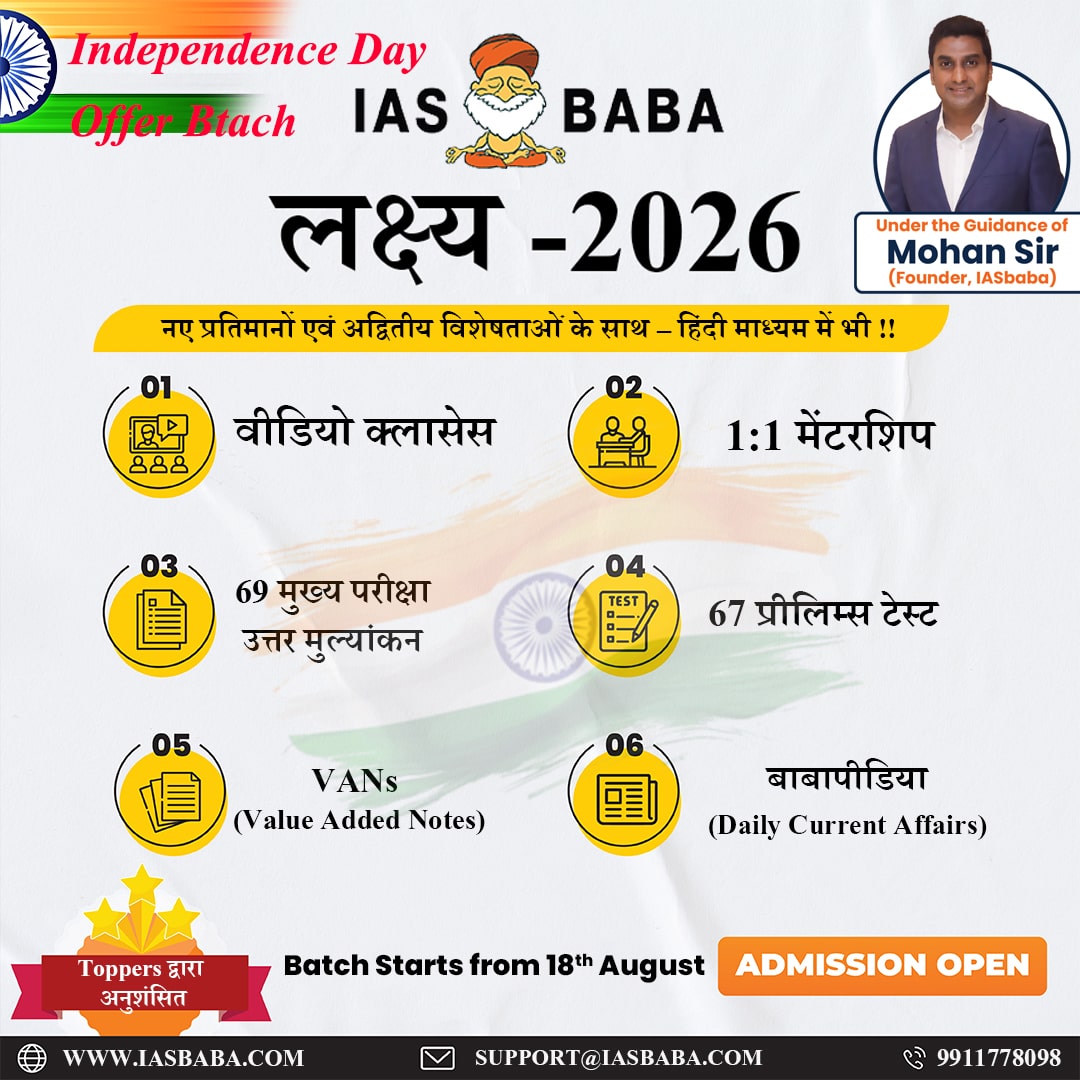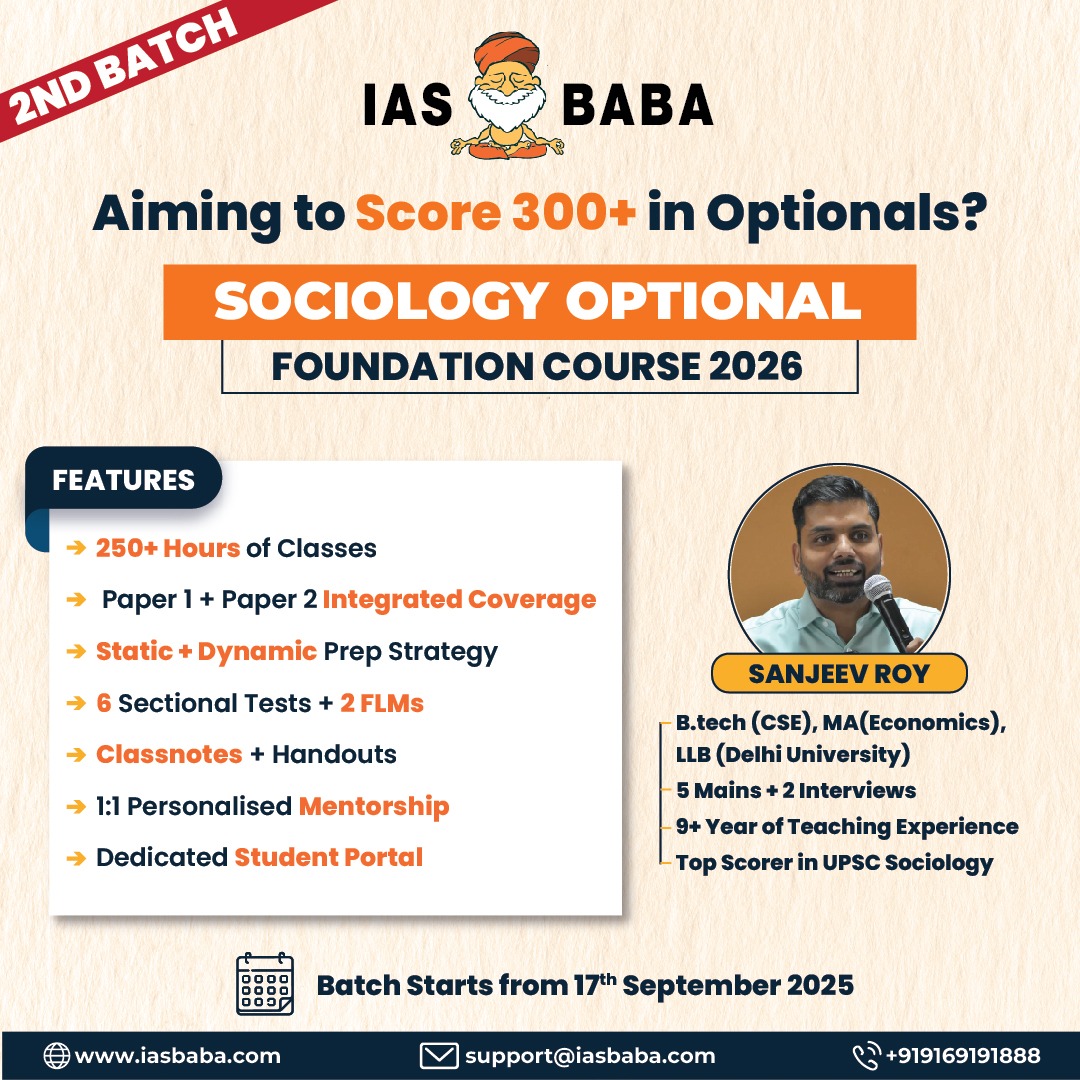IASbaba's Daily Current Affairs Analysis
Archives
(PRELIMS Focus)
Category: INTERNATIONAL
Context: Iran’s parliament is moving forward with legislation to suspend all cooperation with the International Atomic Energy Agency (IAEA),
Decoding Context:
Key Points:
- It proposes halting:
- Installation of IAEA surveillance cameras
- On-site inspections
- Reporting to the IAEA
- These measures would remain suspended until Iran receives “objective guarantees” on the IAEA’s neutrality and security assurances for its nuclear sites.
Iran’s Standpoint:
- Iranian leaders accuse the IAEA of bias and of acting under political influence.
- The move is seen as a response to perceived threats to Iran’s nuclear infrastructure and national sovereignty.
International Response:
- The IAEA has convened an emergency meeting and urged renewed diplomacy to prevent further escalation.
- Western nations have expressed concern, warning that reduced oversight could raise nuclear proliferation risks.
Implications:
- If passed by the full parliament, the bill would drastically reduce transparency into Iran’s nuclear program.
- It could heighten regional instability and deepen Iran’s international isolation.
Learning Corner:
International Atomic Energy Agency (IAEA)
The International Atomic Energy Agency (IAEA) is a specialized agency of the United Nations established in 1957. Its headquarters is in Vienna, Austria.
Purpose:
- Promote the peaceful use of nuclear energy.
- Prevent the spread of nuclear weapons (non-proliferation).
- Ensure nuclear safety and security worldwide.
Key Functions:
- Safeguards and Verification:
- Inspects nuclear facilities in member states to verify that nuclear materials are not diverted to weapons programs.
- Technical Assistance:
- Helps countries develop nuclear technology for uses in medicine, agriculture, energy, etc.
- Standards and Safety:
- Sets international safety standards for nuclear operations and radiation protection.
- Crisis Monitoring:
- Responds to nuclear emergencies and monitors compliance with international agreements like the Nuclear Non-Proliferation Treaty (NPT).
Structure:
- General Conference: All member states meet annually.
- Board of Governors: Makes key policy decisions.
- Secretariat: Executes daily functions, headed by the Director General.
Source: THE HINDU
Category: INTERNATIONAL
Context: The Iranian parliament has approved a proposal to close the Strait of Hormuz in retaliation for recent U.S. airstrikes on its nuclear sites
Strategic Importance of the Strait
- Located between Iran and Oman, it handles 20–30% of global oil shipments and a major share of liquefied natural gas (LNG) exports.
- Closure would cause a global supply shock and spike oil prices.
Impact on India
- India imports:
- ~50% of its crude oil
- ~60% of natural gas via the Strait.
- A blockade could:
- Push Brent crude to $110–$130 per barrel.
- Trigger domestic fuel inflation, increase transport and production costs, and hurt GDP growth.
Learning Corner:
Strait of Hormuz
The Strait of Hormuz is one of the world’s most strategically important maritime chokepoints, located between Iran and Oman, connecting the Persian Gulf with the Gulf of Oman and the Arabian Sea.
Key Facts:
- Width: Narrowest point is about 33 km (21 miles) wide.
- Shipping Lane: Only 3 km wide in each direction, with a 2 km buffer zone.
- Oil Transit:
- Carries 20–30% of global seaborne oil shipments.
- Nearly 17–18 million barrels of oil per day pass through.
- Natural Gas: Major route for liquefied natural gas (LNG), especially from Qatar.
Geopolitical Importance:
- Borders Iran to the north and UAE and Oman to the south.
- Iran has previously threatened to close the Strait during tensions with the West.
- Any disruption here can cause a global energy crisis and spike in oil prices.
Source: THE HINDU
Category: HISTORY
Context : Okinawa commemorated the 80th anniversary of the end of the Battle of Okinawa on June 23, 2025
Historical Context:
- The Battle of Okinawa began on April 1, 1945, and ended on June 22, 1945.
- It was one of World War II’s deadliest battles, with around 200,000 deaths, including over 188,000 Japanese (many Okinawan civilians) and 12,000 Americans.
- About 25% of Okinawa’s population was killed.
- The destruction led to U.S. occupation for 27 years and a lasting American military presence.
Legacy:
- The battle remains central to Okinawa’s identity and Japan’s pacifist outlook.
- Monuments like the Cornerstone of Peace honor those lost and underscore Okinawa’s mission to share the realities of war and advocate for peace.
Learning Corner:
Major Battles of World War II
Battle of Stalingrad (1942–1943)
- Location: Soviet Union
- Combatants: Nazi Germany vs Soviet Union
- Significance: Turning point on the Eastern Front; marked the beginning of German retreat.
- Outcome: Decisive Soviet victory; one of the bloodiest battles in history.
Battle of El Alamein (1942)
- Location: Egypt (North Africa)
- Combatants: British-led Allied forces vs German-Italian Axis forces
- Significance: Ended Axis threat to the Suez Canal; major Allied victory in North Africa.
D-Day / Battle of Normandy (June 6, 1944 – August 1944)
- Location: France
- Combatants: Allied Forces (US, UK, Canada, etc.) vs Nazi Germany
- Significance: Largest amphibious invasion in history; opened the Western Front in Europe.
- Outcome: Liberation of Western Europe from Nazi control.
Battle of Midway (June 1942)
- Location: Pacific Ocean
- Combatants: United States vs Japan
- Significance: Turning point in the Pacific theatre; U.S. Navy decisively defeated the Japanese fleet.
- Outcome: Japan lost four aircraft carriers; momentum shifted to Allies.
Battle of Britain (1940)
- Location: United Kingdom
- Combatants: Royal Air Force (UK) vs Luftwaffe (Germany)
- Significance: First major military campaign fought entirely by air forces.
- Outcome: British victory; prevented German invasion of Britain.
Battle of the Bulge (December 1944 – January 1945)
- Location: Belgium
- Combatants: Nazi Germany vs Allied Forces
- Significance: Germany’s last major offensive on the Western Front.
- Outcome: Allied victory; German forces weakened severely.
Source : THE HINDU
Category: ENVIRONMENT
Context : According to the WMO’s State of the Climate in Asia 2024, the continent is warming at nearly twice the global average, with 2024 ranking as the warmest or second warmest year ever recorded in Asia.
Decoding Context
Key Findings:
- Temperature Increase:
Asia’s average temperature in 2024 was 1.04°C above the 1991–2020 average. - Extreme Weather:
The warming has intensified heatwaves, floods, droughts, rainfall extremes, and tropical cyclones. - Glaciers and Oceans:
- Glacier melt worsened in the central Himalayas and Tian Shan, with 23 of 24 monitored glaciers losing mass.
- Sea surface temperatures hit record highs; marine heatwaves were the worst on record.
- Human and Economic Impact:
Thousands of deaths, including 159 in India due to heatwaves, and nearly 48,000 cases of heatstroke reported.
Significant economic losses and food insecurity across the region. - Sea Level Rise:
Sea levels on both the Pacific and Indian Ocean coasts of Asia rose faster than the global average, threatening coastal regions.
Regional Highlights:
- High anomalies observed in Western China, Japan, Indochina, West Asia, and Siberia.
- Japan saw its hottest year on record, beating its 2023 high.
Learning Corner:
World Meteorological Organization (WMO)
The World Meteorological Organization (WMO) is a specialized agency of the United Nations responsible for promoting international cooperation in weather, climate, hydrology, and related environmental fields.
Key Facts:
- Established: 1950 (originated from the International Meteorological Organization, 1873)
- Headquarters: Geneva, Switzerland
- Members: 193 Member States and Territories
- Parent Organization: United Nations (UN)
Functions:
- Weather and Climate Monitoring:
Collects, standardizes, and shares meteorological and hydrological data globally. - Early Warning Systems:
Helps countries build systems to prepare for natural disasters like cyclones, floods, droughts, and heatwaves. - Climate Change Reporting:
Publishes major reports such as the State of the Global Climate and State of the Climate in Asia, highlighting temperature trends, sea level rise, and extreme weather. - Scientific Collaboration:
Supports global research and capacity building in climatology, hydrology, marine meteorology, and atmospheric science.
Source: THE INDIAN EXPRESS
Category: ECONOMICS
Context: The Ministry of Statistics and Programme Implementation (MoSPI) will conduct India’s first comprehensive Household Income Survey in February 2026, aiming to bridge a critical gap in national income data.
Key Features:
- Objective:
To assess household income distribution, understand the impact of technology on wages, and support informed economic planning. - Expert Panel:
An 8-member Technical Expert Group (TEG), chaired by Dr. Surjit S. Bhalla, will guide survey design, methodology, sampling, and implementation in line with international best practices. - Historical Gap:
While India has long collected data on consumption, employment, health, and education through the National Sample Survey (NSS), no nationwide income-specific survey has ever been completed due to past methodological challenges.
Significance:
- Will enable precise analysis of income inequality, economic mobility, and the structural shifts in the Indian economy since independence.
- Findings will support policy formulation and resource allocation at both central and state levels.
Learning Corner:
Reports Released by MoSPI (Ministry of Statistics and Programme Implementation)
The Ministry of Statistics and Programme Implementation (MoSPI) is responsible for collecting, analyzing, and publishing statistical data to aid policy formulation and socio-economic planning in India. It functions through two main wings: the Central Statistics Office (CSO) and the National Sample Survey Office (NSSO) (now merged into the National Statistical Office, NSO).
Major Reports Released by MoSPI / NSO:
- National Statistical Office (NSO) Reports:
- Periodic Labour Force Survey (PLFS):
Provides data on employment-unemployment, labor force participation, and worker distribution by sector and gender. - Consumer Expenditure Survey (CES):
Tracks household spending patterns, consumption trends, and helps estimate poverty levels (next round expected after 2011–12). - Household Social Consumption Surveys:
Include topics like Health, Education, and Housing, offering insights into access, usage, and affordability. - Multiple Indicator Survey (MIS):
Captures data on living standards, access to basic amenities, and demographic indicators.
- Central Statistics Office (CSO) Reports:
- Gross Domestic Product (GDP) Estimates:
Quarterly and annual estimates of GDP at constant and current prices for national and sectoral income. - Index of Industrial Production (IIP):
Measures short-term changes in industrial output across sectors like manufacturing, mining, and electricity. - Consumer Price Index (CPI):
Calculates inflation rates based on retail prices for rural and urban consumers. - Annual Survey of Industries (ASI):
Provides detailed industrial statistics, including employment, output, and investment in registered factories.
- Other Key Reports:
- Economic Census:
Covers all entrepreneurial units in India, both agricultural and non-agricultural (excluding crop production). - Vital Statistics of India Based on the Civil Registration System (CRS):
Reports on births and deaths registered across states/UTs. - Household Income Survey (upcoming in 2026):
Will be the first full-scale national survey to collect direct household income data.
Source: THE INDIAN EXPRESS
(MAINS Focus)
Introduction (Context)
A silent transformation is unfolding in rural India through the food processing sector. The food processing sector is emerging not only as a growth engine but also as a powerful tool of rural empowerment, farmers’ income augmentation, and agri-industrial integration.
In 2014, the gross value addition of the sector stood at Rs 1.34 lakh crore. Today, following sustained policy focus and institutional drive, that figure has risen to Rs 2.24 lakh crore.
What is food processing?
- Food Processing refers to the transformation of raw agricultural products into consumable food or intermediate food products using physical, chemical, or biological means.
- It includes operations like cleaning, grading, packaging, preservation, and value addition.
Types:
- Primary Food Processing: Focus on transforming raw agricultural products into a form suitable for further processing or consumption.
-
- Examples:
-
- Fruit and vegetable processing: Washing, sorting, grading, and packaging fruits and vegetables.
- Dairy processing: Separating milk components (e.g., cream, skim milk) and pasteurizing.
- Secondary Food Processing: Focus on applying cooking and preservation techniques to create edible products.
-
- Examples:
-
- Baking: Producing bread, cakes, and pastries.
- Juice extraction and concentration: Processing fruits to extract and concentrate their juices.
- Tertiary Food Processing: Focus on producing ready-to-eat or convenience foods on a large scale.
-
- Examples:
-
- Frozen meals: Preparing and packaging complete meals for microwave heating.
- Snack foods: Producing chips, crackers, and other packaged snacks.
Significance
- The food processing industry act as the link between agriculture and manufacturing.
- It employs the largest number of persons, not just in the formal sector, where it constitutes 12.38 percent of registered employees, but also in the informal sector.
- As per the Ministry of Food Processing, women’s share of employment in registered food processing industries stood at 12.6 percent of total employment, whereas the number in the unregistered industries was almost a double and stood at 24.7 percent.
- The sector can contribute immensely to the empowerment of farmers, especially females, by providing improved bargaining power to them, leading to reduction in distress sales and ensuring steady supply to the processors.
- The food processing industry contributes significantly to India’s GDP, accounting for a substantial percentage of the total.
- The industry is a major contributor to India’s export earnings, with processed foods gaining increasing prominence in the international market.
- It attracts considerable industrial investment, further boosting economic activity and development.
- Food processing increases the value of agricultural products by transforming them into marketable goods, reducing wastage, and creating value-added products.
- By processing agricultural produce, the industry helps farmers get better prices for their products, contributing to increased income and improved livelihoods.
- Processing extends the shelf life of perishable agricultural produce, minimizing losses due to spoilage and wastage.
- The demand for various processed foods encourages farmers to diversify their crops, reducing dependence on a few staple crops.
- Food processing helps streamline the supply chain, ensuring a more efficient and reliable flow of agricultural products from farm to consumer.
- Processed foods play a crucial role in making food available to a wider population, including those in remote areas, by extending shelf life and improving accessibility.
- Fortified processed foods can help address nutritional deficiencies by adding essential vitamins and minerals, contributing to better public health.
- By processing and preserving food, the industry helps minimize food wastage, ensuring more food reaches consumers.
Government initiatives
- Pradhan Mantri Kisan SAMPADA Yojana (PMKSY): A comprehensive scheme to boost food processing infrastructure, reduce wastage, and create employment by supporting Mega Food Parks, cold chains, and agro-processing clusters.
- PM Formalisation of Micro Food Enterprises (PMFME): A ₹10,000 crore scheme under Atmanirbhar Bharat to support unorganised micro food businesses through formalisation, training, credit access, and SHG support.
- Production Linked Incentive (PLI) Scheme for Food Processing: Provides financial incentives to boost large-scale food manufacturing, enhance global competitiveness, and generate employment through ₹8,900 crore committed investment.
- Operation Greens: Initially aimed at stabilising the supply of tomato, onion, and potato (TOP), the scheme now covers 22 perishable crops to ensure fair prices and reduce wastage.
- Agriculture Infrastructure Fund (AIF): A ₹1 lakh crore fund aimed at developing farm-gate and aggregation infrastructure including cold storage, packhouses, and value chains for pre-processing.
- One District One Product (ODOP): Promotes unique local agro-products by providing marketing, branding, and export support, integrating districts into the national food value chain.
- 100% FDI in Food Processing Sector: Permits full foreign direct investment under the automatic route to attract global capital and technology in food manufacturing and retail.
- Formation of 10,000 Farmer Producer Organisations (FPOs): Aggregates farmers into structured collectives to enhance their bargaining power, ensure better market access, and support value chain integration.
- National Makhana Board (2024–25 Budget): Announced to boost value addition, branding, and global market access for makhana and promote regional superfoods.
- Support for Food Testing & Irradiation Infrastructure: Establishment of 100 National Accreditation Board for Testing and Calibration Laboratories accredited labs and 50 irradiation units to improve food safety, shelf life, and export readiness.
Achievements
- Under Kisan SAMPADA Yojana Over 1,604 projects approved with ₹22,000 crore in private investment. 53 lakh farmers benefited and 7.6 lakh jobs generated.
- Under PM Formalisation of Micro Food Enterprises (PMFME) Over 1.41 lakh loans approved worth ₹11,205 crore, 3.3 lakh SHG members supported via seed capital
- Operation Greens extended to 22 perishable crops
Challenges
At the Farm Level:
- Lack of awareness about quality and food safety standards
- Absence of processable varieties
- Inadequate aggregation centres and cold chains
- Shortage of packhouses, refrigerated vehicles, and value-chain infrastructure
- Rising income and organised retail fueling demand for processed and healthier food products.
- Shift in consumer behaviour toward convenience, quality, and traceability.
Environmental & Production Risks:
- Depleting soil health and water tables
- Overuse of fertilisers and pesticides
- Need for sustainable practices like micro-irrigation and balanced nutrient management
Steps needed
- Invest in cold chains, packhouses, and last-mile transport
- Promote FPO-led aggregation models
- Increase awareness of Codex Alimentarius and global health standards
- Promote consumer-centric innovation with emphasis on traceability and nutrition
- Encourage export-oriented processing and branding of regional specialties
- Focus on climate-smart agriculture
- Promote value chain partnerships with private sector and cooperatives
- Enhance skills and entrepreneurship through training and incubation
Conclusion
India’s food processing sector stands at the intersection of rural livelihoods, agri-exports, and innovation. With sustained reforms and institutional support, it is not just feeding India — but also branding Bharat globally. By empowering farmers, especially women, and integrating local produce with global markets, it holds the promise of inclusive growth, employment, and food security in the decades to come.
Mains Practice Question
Q Food processing is key to transforming India’s agriculture from a volume-based system to a value-based economy. Discuss the significance of the sector and the steps taken by the government in recent years to harness its full potential. (250 words, 15 marks)
Introduction (Context)
South Asia is among the least economically integrated regions globally. Despite geographic proximity and shared history, intra-regional trade under SAFTA accounts for just 5–7% of South Asia’s total trade—much lower than EU (45%), ASEAN (22%), or NAFTA (25%). Current intra-SAARC trade stands at $23 billion, compared to a potential of $67 billion or more (UNESCAP).
Rising economic nationalism, border disputes, and terror threats undermine regional cooperation. This lack of integration has deep implications for both economic growth and national security..
What is SAARC?
- South Asian Association for Regional Cooperation (SAARC), established in 1985, is a regional organization aimed at promoting economic, cultural, and political cooperation in South Asia.
- Member countries: Afghanistan, Bangladesh, Bhutan, India, Maldives, Nepal, Pakistan, Sri Lanka.
- These nations together form one of the world’s most populous regions and share deep cultural, historical, and economic ties.
- Among them, India plays a dominant role—both as an economic powerhouse and as a geopolitical influencer.
Current Status/challenges in SAARC
- South Asia accounts for 25% of the world’s population but only $5 trillion in GDP. In contrast, EU (5.8% of global population) has a GDP of $18 trillion, and NAFTA has $24.8 trillion
- South Asia’s trade-to-GDP ratio fell from 47.3% (2022) to 42.9% (2024). Trade costs within the region are 114% of the goods’ value, higher than with the U.S. (109%)
- Economic instability fuels unrest; unrest and conflict disrupt trade. Example: India-Pakistan trade fell from $2.41 billion (2018) to $1.2 billion (2024) due to terrorism and border tensions.
- A study by UNESCAP estimated that South Asia’s trade potential could have reached $172 billion by 2020. However, actual intra-SAARC trade stood at just $23 billion—less than a third of its potential. This unexploited capacity is highest in countries like Bangladesh (93% untapped), Maldives (88%), Pakistan (86%), and Nepal (76%).
- Furthermore, the region faces widening trade deficits, with the cumulative deficit expanding from $204.1 billion in 2015 to $339 billion in 2022. All of this is happening even as overall trade volume (imports + exports) increased to $1,335 billion in that period.
- But perhaps the most pressing concern is the cost of intra-regional trade. It is 114% of the value of goods exchanged—more expensive than trading with the United States, despite its geographic distance. For example, it costs a company in India 20% more to trade with Pakistan than with Brazil, which is 22 times farther away. This cost inefficiency discourages businesses from forming regional value chains and limits competitiveness. In contrast, intra-regional trade costs in ASEAN are only 76%, incentivising tighter economic cooperation and interdependence.
- Agreements are routinely signed but rarely implemented. Summits are postponed indefinitely due to bilateral tensions.
- Important initiatives like the SAARC Motor Vehicles Agreement or the South Asian University are either non-functional or underfunded.
- The failure to institutionalise decision-making and enforcement mechanisms has made SAARC largely symbolic.
Causes
- Border disputes, terrorism, and weak transport and trade infrastructure have led to the deterioration of key bilateral trade relationships most notably between India and Pakistan, but also with Nepal and Sri Lanka.
- This fragmentation reduces the ability of countries to benefit from economies of scale, regional supply chains, or cross-border innovation networks.
Steps needed
To revive South Asian economic integration, a multipronged approach is necessary:
-
Reform and Strengthen SAARC Mechanisms: Agreements like SAFTA must be implemented in letter and spirit. Trade liberalisation should not remain symbolic but must lead to real reductions in tariffs, simplification of trade procedures, and mutual recognition of standards.
- Invest in Cross-Border Infrastructure: Building transport corridors, energy grids, and digital connectivity can reduce the cost of doing business and foster regional value chains. India’s initiatives under BBIN (Bangladesh, Bhutan, India, Nepal) and BIMSTEC should be expanded and synergised with SAARC goals.
- Depoliticise Trade Relations: Economic collaboration must be delinked from political hostility. While political dialogue is crucial, countries must not hold trade hostage to diplomatic deadlocks.
- Encourage People-to-People Links: Strengthening academic exchanges, tourism, and civil society partnerships can rebuild trust, which is the foundational requirement for regional cooperation.
- Focus on Trade in Services and Digital Economy: South Asia has a huge untapped potential in sectors like tourism, fintech, digital health, and education. Regional frameworks must facilitate cross-border investment and collaboration in these emerging areas.
Conclusion
SAARC had the aim of ending distrust and tension, but trust deficits and regional conflicts hinder the full implementation of agreements such as SAFTA. Political diversity, regional disputes, minority issues and terrorism are major obstacles to regional cooperation. Most SAARC countries are in conflict with each other, preventing effective regional integration. Lesser trade opportunity means lesser capacity for innovation, production and investment in the people of the country. Therefore, to exploit the full potential of the South Asian region, members must work actively to enhance intra-regional trade, keeping aside their bilateral conflicts.
Mains Practice Question
Q “The failure of South Asian regional integration lies more in political mistrust than economic potential.” Discuss with examples. (250 words, 15 marks)
Daily Practice MCQs
Today’s – Daily Practice MCQs’ will be updated in our “Daily Current Affairs Quiz” section on our website
Please click on the below link



